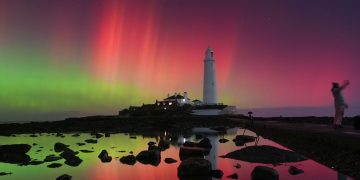A MASSIVE Alaskan volcano is on the brink of erupting — and terrified experts warn it could happen within weeks.
Mount Spurr, the 11,000-foot behemoth sitting just 80 miles west of Anchorage, has been rumbling with frequent small earthquakes as scientists fear it’s moving closer to an explosive eruption.


Experts predict the volcano – pictured here erupting in 1992 – could blow again in just a few weeks[/caption]

The potential blast, experts say, could unleash global travel chaos and choke a critical cargo route between North America and Asia.
The Alaska Volcano Observatory (AVO) said in a chilling update: “Unrest continues at Mount Spurr.”
“Most of the earthquakes that are occurring under the volcano are too small to be located.”
If it blows, the fallout could disrupt air travel worldwide as the ash is taken by the winds and makes flying impossible.
Mount Spurr could shoot an ash cloud 50,000 feet into the air, forcing nearby Ted Stevens Anchorage International Airport (ANC) and Fairbanks International Airport (FAI) to shut down — sparking a ripple effect across global air travel.
“Mount Spurr has the potential to snare travel and cargo logistics, resulting in disruptions that extend far beyond the Alaskan border,” experts warned.
Back in 2010, a volcano in Iceland erupted and spewed a cloud of ash across vast areas of Europe and the Atlantic.
For eight days, 300 airports were completely closed and a staggering 100,000 flights cancelled.
Some 10million passengers were affected, with the airline industry reporting a total loss of over £1billion.
The AVO has been tracking the volcano’s increasing activity since April 2024, monitoring telltale signs like shallow quakes, ground deformation, and gas and steam emissions.
And they all point to one thing — that magma level is rising.
Scientist-in-charge Matt Haney told the Daily Mail that if Spurr blows again, the event ‘would be explosive,’ adding it would likely mimic the volcano’s last eruption in 1992.
Back then, three blasts rocked Alaska over the summer, with August’s eruption shutting down Anchorage’s airport for 20 hours and blanketing the city in an eighth of an inch of ash.
Commerce ground to a halt, office buildings shuttered, and $2 million in damages were reported.
The ash isn’t just a nuisance — it’s deadly to aircraft. Its fine particles can shred engines, corrode cockpit windows, damage fuselage, and knock out vital instruments mid-flight.
“It is extremely dangerous to fly a plane while a volcanic eruption is occurring nearby,” the AVO warned.
ANC is a crucial cog in the global supply chain — the world’s fourth-busiest cargo airport, handling over 8,000 freight flights each month.
Even minor disruptions can delay shipments, e-commerce, and manufacturing deliveries.
Iceland 2010 eruption
IN 2010, volcanic eruptions from a mountain called Eyjafjallajökul in Iceland wreaked havoc with Europe’s air travel.
The eruption was relatively small but its impact was massive.
A series of volcanic events between March and June spewed huge clouds of ash into the sky.
At its peak, the ash cloud was more than 9km high, and spread across vast areas of Europe and the Atlantic Ocean.
Europe experienced air travel chaos for almost a month as much of the continent ground to a standstill.
The ice-capped volcano started to erupt in mid-March, following several months of increased seismic activity in Iceland.
Eruptions were initially contained to one flank of the mountain, but trouble started when they spread to the centre of the three kilometre-wide, iced-over crater.
The ice melted and glacial water began flooded into the crater, metting the scalding magma.
This rapid cooling caused the magma to shear into fine, jagged ash particles which rose into the air as thick clouds.

Mount Spurr last erupted in 1992, causing major disruption to Anchorage[/caption]

Enormous plumes of smoke engulfed the skies[/caption]
A total shutdown would bring it all to a standstill.
And as one of the top diversion and refuelling spots for polar and Pacific air routes, any closure at ANC or FAI would force passenger flights from Asia, Europe, and North America to divert, triggering delays and chaos across multiple continents.
“There are no residents living in the ‘identified hazard areas for pyroclastic flows and lahars,’” the AVO said.
But the ashfall could rain on Anchorage and spread across the central US within days — just as it did in 1992.
The mountain’s warning level was upgraded from green to yellow in October 2024 after a small lake formed in its summit crater.
Since then, “seismic activity remained elevated with numerous small, shallow volcanic earthquakes detected beneath the volcano,” the AVO reported.
Experts say the final red flag will be a volcanic tremor — a constant shaking that lasts minutes to days — signaling magma is on the move.
That’s exactly what happened three weeks before Mount Spurr blew in June 1992.
“Alaska’s Mount Spurr is about to erupt. Be ready,” the AVO posted on X.
And with the clock ticking, officials are urging residents and air traffic operators alike to brace for a blast that could bring the skies — and global trade — to a grinding halt.
How do volcanoes erupt?
- Volcanoes are formed when a hot liquid like substance called magma breaks through the Earth’s crust
- Once the magma reaches the surface and gushes into the air, this is known as a volcanic eruption
- Volcanic eruptions can release lava, rocks, dust, volcanic ash and toxic gases into the atmosphere
- Some eruptions are huge and kill lots of people but other eruptions can be small flows of lava that are easily avoided
- Volcanoes normally give off warning sides before an eruption occurs, such as tremors or gases, and this gives people nearby time to evacuate




























